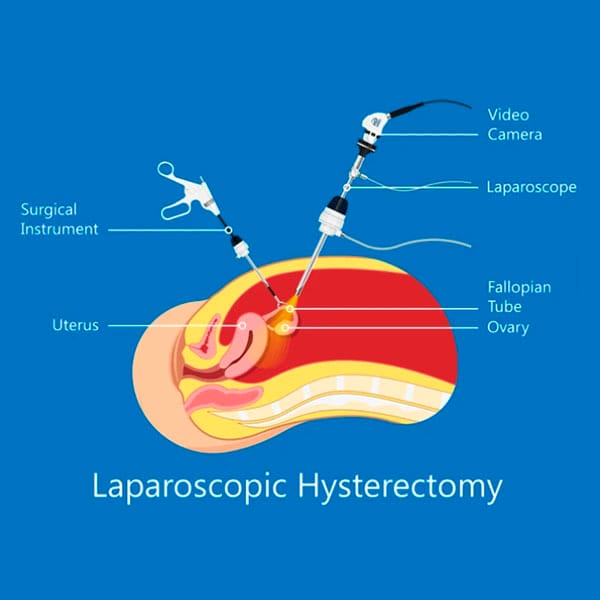What Are Laparoscopic Myomectomy and Hysterectomy Surgeries?
 Laparoscopic myomectomy and laparoscopic hysterectomy are minimally invasive surgical procedures used to treat conditions like fibroids or cancer. A myomectomy is performed to remove uterine fibroids, which are non-cancerous growths in the uterus. It saves your uterus and maintains your fertility. A hysterectomy, on the other hand, is a procedure in which the entire uterus or part of it is removed.
Laparoscopic myomectomy and laparoscopic hysterectomy are minimally invasive surgical procedures used to treat conditions like fibroids or cancer. A myomectomy is performed to remove uterine fibroids, which are non-cancerous growths in the uterus. It saves your uterus and maintains your fertility. A hysterectomy, on the other hand, is a procedure in which the entire uterus or part of it is removed.
When you have uterine cancer or severe endometriosis, a total or partial hysterectomy is suggested. Advanced tools like TruClear™ and Aveta Systems® are involved in both procedures to provide your doctor enhanced precision.
Dr Felix Cohen at Cohen Medical Practice (CMP) in New York City is a board-certified OB-GYN who specializes in advanced gynecological services. He’s an expert in treating fibroids, ovarian polyps, ovarian cysts, and infertility issues. He believes in using advanced tools like TruClear and Aveta Systems, and with years of experience in reputable hospitals, he has a tremendous track record.
Why Might I Need a Laparoscopic Myomectomy or Hysterectomy?
Your doctor may recommend one procedure if you’re having unexplained bleeding or pelvic pain. Causes include malignant tissues or a uterine lining growing outside of your uterus. A laparoscopic myomectomy or laparoscopic hysterectomy can provide you relief from unmanageable bleeding and pain.
You may experience these symptoms if you have conditions such as:
- Uterine fibroids
- Uterine cancer
- Endometriosis
- Uterine prolapse
- Iron deficiency anemia
Laparoscopic hysterectomy cancer treatment is one option when your doctor finds malignant tissues. A laparoscopic myomectomy vs. abdominal myomectomy are other treatments that differ in the surgical approach, as an abdominal myomectomy is an open surgery with a large incision giving access to the uterus. It’s usually recommended if you have several uterine tumors.
Who Is a Candidate for a Myomectomy or Hysterectomy?
You may not be a fit for a myomectomy or a hysterectomy if your fibroids are large and are in a position that’s difficult to remove laparoscopically. In this case, your surgeon may recommend an open myomectomy.
Additional situations that may preclude you from being a good candidate for a myomectomy and hysterectomy include:
- Enlarged uterus
- Previous abdominal surgeries
- Significant scar tissue
- Obesity
If you have uterine or ovarian cancer, you may go through laparoscopic hysterectomy cancer treatment. Another approach called robotic hysterectomy benefits a laparoscopic hysterectomy for cancer as it allows extreme precision in surgical movement. The advanced instrumentation allows for fine control, which is important around delicate structures and tissues.
Other advantages of robotic hysterectomy tools include:
- High-definition 3D imaging
- Enhanced depth perception
- Reduced hand tremors
- Less tissue damage
- Smaller incisions
- Reduced laparoscopic hysterectomy scars
How Is a Laparoscopic Myomectomy or Hysterectomy Surgery Performed?
A laparoscopic myomectomy or hysterectomy is performed using specialized instruments and small incisions. Before the procedure, you undergo a full regimen of blood tests and imaging.
The next steps in a laparoscopic myomectomy or hysterectomy include:
- Making small incisions in the abdominal wall, through which a laparoscope and other surgical instruments are inserted
- Creating images of your organs on a nearby monitor so your surgeon can view your uterus and any fibroids or abnormalities
- Removing the fibroids from the uterine wall, preserving the uterus if you’re having a myomectomy, although the approach varies, depending on the size and location of the fibroid
- Removing the uterus if you’re having a hysterectomy
- Reconstructing the uterine wall following a myomectomy
TruClear system may be used to remove the fibroids as it’s equipped with suction and cutting mechanisms, which help in extracting the fibroids and reducing blood loss and trauma. In a hysterectomy, Aveta Systems assists in the procedure by providing your NYC surgeon with enhanced visuals and control, making sure the removal is precise.
What Is Recovery Like for These Procedures?
Both procedures take between one and three hours. During either procedure, you won’t feel any pain as general anesthesia is given. After a myomectomy, you should be able to resume full-time activities in about five weeks. Following a hysterectomy, the full recovery period takes between six and eight weeks.
After your procedure, take medicines as instructed. Apply heating pads and cold packs to minimize pain. Keep the site of incisions clean and dry and change dressings properly. Try walking to promote circulation but avoid heavy physical exercises. Start with eating light foods that are easy to digest and return to your normal routine slowly.
Call your surgeon if you experience symptoms, such as:
- Extreme pain or cramping
- Bleeding and discharge from the incisions
- Infection signs like fever, redness or swelling
- Pain while urinating or constipation
Are There any Side Effects to Laparoscopic Myomectomy or Hysterectomy Surgery?
Myomectomy and hysterectomy come with risks and side effects, but with the right care and management, it’s drastically reduced. Dr. Felix Cohen at CMP New York is an experienced gynecologist who uses his vast training time to create strategies that minimize risks and side effects.
His management in reducing these risks and side effects includes:
- Open communication with you
- Detailed assessment and evaluation
- Using tools like TruClear System and Aveta Systems
- Using minimally invasive approaches
- Monitoring you to catch issues in a timely manner
- Robotic assistance
- Experienced pain management
- Detailed wound care instructions
If you have gotten a total hysterectomy, you may have some hormonal changes that affect sex after hysterectomy and which Dr. Cohen addresses. Tackling all these hysterectomy complications can be difficult if you don’t have someone experienced and professional on your side like the CMP New York team. To receive the most accurate diagnosis and effective treatment and surgeries, contact Cohen Medical Practice (CMP) for a consultation.

